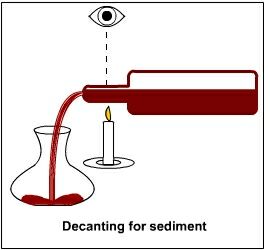 A Server's Perspective
A Server's PerspectiveThe Basics of Decanting
By Jorge Eduardo Castillo
Many years ago while working as a server at my first fine-dining restaurant, I learned the hard way about why and how to decant wine. There was a veteran server there who used to decant every bottle of wine a guest ordered, regardless of varietal, vintage, or anything else.
Not only did he indiscriminately decant every bottle, but he would also pour the wine into a second decanter. Not only did he pour the wine into a second decanter, but he poured the wine back and forth from decanter to decanter about four or five times. When I asked him why he did this, he told me that he was putting on a show for his tables and that it showed he really cared about his guests.
This being my first fine-dining job and not knowing much about wine, his explanation made sense to me so I did the same for my tables. After about a week of rigorous and relentless decanting of every bottle of wine my guests ordered, one gentleman who ordered a nice Pinot Noir stopped me in the middle of my performance and asked: "What in the world are you doing to my wine?" I explained that this would open the wine up and it would show better.
Obviously he was more knowledgeable than I when it came to wine, and he took the time to explain to me that there are specific reasons for decanting and not every bottle of wine should be decanted. While moderately embarrassing, this situation motivated me to take the time to learn about the nuances of decanting so I would never put myself in that position again.
Why decant?
There are two primary reasons to decant a bottle of wine:
- To introduce air to the wine more quickly as a way to open it up (allow the aromatics to show), and
- to separate the wine from sediment that is in the bottle.
Most medium- to full-bodied young wines (2-9 years old) would benefit from the added exposure to air. Also, younger wines tend to be "tight" out of the bottle and will often not show their personality until they have seen a decent amount of air. I liken it to a flower blooming - as air hits the wine, the flower slowly opens from its bud, and after a certain period of time the flower reaches full bloom. When a wine has completely opened, you will get the bouquet and flavors that the wine was meant to display, just as you would see the colors and shapes a flower was meant to show when it has reached full-bloom.
Many older wines, especially full-bodied reds, will have a build-up of sediment in the bottle which can interfere with enjoyment of the wine if it finds its way into the glass. In order to avoid the unpleasant feeling of having grit or "gravel" in your mouth, it is recommended that you separate the sediment from the wine (more on how to do that later).
It should be noted that some young wines "throw" sediment, so they should be decanted as well. Pay particular attention to full-bodied Syrah-based wines from Australia as they can often contain clay-like sediment at the bottom of the bottle. Other sediment can best be described as silt, tartrates, stems or particles that have fallen out of the wine.
How to decant?
 When decanting for air, there really are no tricks or hidden concepts. Simply open the bottle and pour the wine into the decanter. I recommend that you pour so the wine directly hits the bottom of the decanter rather than letting it pour down the side. The splashing when the wine hits the bottom of the decanter will help expedite the oxidation process and the wine will open more quickly. For very full-bodied wines, I recommend decanting several hours in advance. You do not want to spill any of the wine, so until fully comfortable, do this as slowly and carefully as necessary.
When decanting for air, there really are no tricks or hidden concepts. Simply open the bottle and pour the wine into the decanter. I recommend that you pour so the wine directly hits the bottom of the decanter rather than letting it pour down the side. The splashing when the wine hits the bottom of the decanter will help expedite the oxidation process and the wine will open more quickly. For very full-bodied wines, I recommend decanting several hours in advance. You do not want to spill any of the wine, so until fully comfortable, do this as slowly and carefully as necessary.
When decanting to remove the wine from its sediment, a few methods are popular among wine lovers. I'm a traditionalist, so I prefer to do it the way they did in the old days. With this method, you light a candle and hold it so the flame is a few inches under the neck of the bottle (you don't want to heat the wine). As the wine pours out through the neck, the candlelight will help you see the sediment as it starts to leave the bottle and that will alert you to stop pouring (see diagram).
The other method is much less involved, but is effective nonetheless. Simply place a wine strainer over the decanter and pour the wine through the strainer. The strainer should trap most of the sediment.
Moving forward
As you become more comfortable with why and how to decant, you will start to make a mental rolodex of specific wines and wine types that need to be decanted, and whether they are being decanted for air, for sediment, or both.
The best-case scenario here is that you are showing the wine the respect it deserves and offering the product as it should be consumed. This will allow you to subtly demonstrate your wine knowledge and competence to your guests. And, at the very least, you will save yourself from an embarrassing situation like I experienced years ago.
July 2007
Visit www.vino101.com for more details.
Back to the Vino 101 index page




